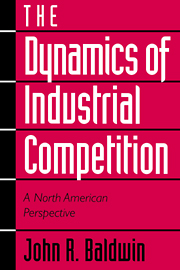Book contents
- Frontmatter
- Contents
- preface
- Acknowledgements
- 1 The dynamics of competition
- 2 Greenfield entry and closedown exit
- 3 Entry, exit, and the merger process
- 4 The rise and fall of incumbents
- 5 Patterns of large- and small-firm mobility
- 6 Plant turnover in Canada and the United States
- 7 Measures of market structure and the intensity of competition
- 8 The relationship between mobility and concentration
- 9 Turnover and productivity growth
- 10 Merger success
- 11 Turnover in domestic and foreign enterprises
- 12 Industry efficiency and firm turnover in the Canadian manufacturing sector
- 13 Firm turnover and profitability
- 14 Modelling entry
- 15 Conclusion
- Appendix A Measuring firm turnover – methodology
- Appendix B Definition of concentration and mobility measures
- Notes
- References
- Author index
- Subject index
11 - Turnover in domestic and foreign enterprises
Published online by Cambridge University Press: 30 March 2010
- Frontmatter
- Contents
- preface
- Acknowledgements
- 1 The dynamics of competition
- 2 Greenfield entry and closedown exit
- 3 Entry, exit, and the merger process
- 4 The rise and fall of incumbents
- 5 Patterns of large- and small-firm mobility
- 6 Plant turnover in Canada and the United States
- 7 Measures of market structure and the intensity of competition
- 8 The relationship between mobility and concentration
- 9 Turnover and productivity growth
- 10 Merger success
- 11 Turnover in domestic and foreign enterprises
- 12 Industry efficiency and firm turnover in the Canadian manufacturing sector
- 13 Firm turnover and profitability
- 14 Modelling entry
- 15 Conclusion
- Appendix A Measuring firm turnover – methodology
- Appendix B Definition of concentration and mobility measures
- Notes
- References
- Author index
- Subject index
Summary
Introduction
There is considerable diversity in the type and intensity of turnover both across and within industries. On the one hand, the rates of entry, exit, and continuing-firm displacement differ across industries. On the other hand, there is considerable heterogeneity within industries; firms are not subject to the same uncertainties. Age and size are two characteristics that have been shown in previous chapters to affect the performance of different firms within industries. This chapter examines whether the nationality of a firm also differentiates firms and affects intra-industry firm performance.
Foreign-controlled firms are seen to embody a different form of organization than are domestic-controlled firms, to be able to coordinate larger operations, to possess superior technologies, to access strategic sources of raw materials more efficiently (Rugman, 1980). As a result, there are substantial differences between the plants of domestic-controlled and foreign-controlled firms in the Canadian manufacturing sector. The parents of foreign-owned plants were more diversified across industries (Table 11–1). Within each industry, the foreign-owned plants were more specialized. Combined with their larger average size, the greater degree of specialization in foreign plants meant that their production runs were longer and economies of scale in product lines easier to exploit. Concomitantly, foreign-owned plants had higher labour productivity and higher remuneration rates. While the salary paid to non-production workers was much the same in the two populations, foreignowned plants employed a larger proportion of their work-force in higher-paid white-collar jobs, since a larger proportion of their total work-force was classified as non-production workers.
These differences indicate that foreign and domestic firms are drawn from different populations.
- Type
- Chapter
- Information
- The Dynamics of Industrial CompetitionA North American Perspective, pp. 263 - 297Publisher: Cambridge University PressPrint publication year: 1995



